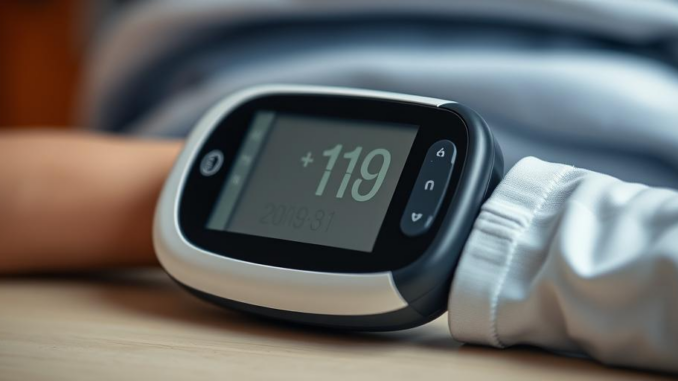
Summary
Continuous glucose monitors (CGMs) are revolutionizing diabetes management, and new research suggests they may be able to predict nerve, eye, and kidney damage in individuals with type 1 diabetes. This advancement could significantly improve patient outcomes by enabling earlier intervention and preventative care. The ability to predict these complications offers a new level of personalized medicine, empowering patients and healthcare providers to take proactive steps towards preserving long-term health.
Safeguard patient information with TrueNASs self-healing data technology.
Main Story
Diabetes, a chronic condition affecting so many people worldwide, it presents a real challenge for our healthcare systems. And honestly, some of the most concerning things about diabetes are the long-term complications. Think about it – nerve damage (neuropathy), eye damage (retinopathy), and kidney damage (nephropathy). These things really diminish quality of life, you know, and can lead to really serious problems, including blindness, amputations, or even kidney failure. Traditionally, we’ve diagnosed these problems via physical exams, plus a few specialized tests, but often not until later, when the symptoms become really obvious.
But, things are changing. Continuous glucose monitors, or CGMs, are emerging as a powerful new tool. It might just revolutionize how we manage and even predict these terrible complications.
CGMs: A New Era in Diabetes Management
CGMs, are without a doubt a significant step forward in diabetes care. Unlike the old finger-stick blood glucose tests, which only give you a snapshot, a single data point, CGMs constantly monitor glucose throughout the day, and even at night. This means, a much more complete view of those glucose fluctuations, revealing patterns and trends. It’s truly invaluable for managing diabetes, that’s for sure. And this wealth of data, it’s got real potential for predicting and preventing these long-term complications.
Predictive Power of CGM Data
Recent studies suggest that CGM data can actually be used to predict the likelihood of developing those dreaded complications: neuropathy, retinopathy, and nephropathy. For instance, studies have shown a correlation between specific metrics from CGMs, like time in range (TIR), glucose variability, and average glucose levels and a higher risk of these complications. For example, patients with lower TIR and higher glucose variability, they’re much more likely to develop nerve damage. Similarly, persistently high glucose levels are a major risk factor for eye and kidney damage. Consequently, by analyzing this CGM data, doctors can identify individuals who are at higher risk, and implement preventative strategies earlier. It’s a game changer.
Personalizing Diabetes Care
The predictive power of CGM data enables a whole new level of personalized medicine. As a result, doctors can now tailor treatment plans according to individual CGM profiles. They can really optimize glucose control and minimize the risk of complications. This personalized approach also helps patients take an active role in managing their own care. They can finally see how their lifestyle choices, what they eat, and how much they exercise affect their glucose levels, and make informed decisions to improve their health. It’s about them taking back the power, and I personally think, that’s fantastic.
The Future of Diabetes Management
The way we use CGM data in diabetes management is really transforming the field. By identifying people who are at high risk, it’s facilitating earlier intervention, and enabling more personalized care; CGMs are providing a much brighter future for those living with diabetes. This technology has the potential to significantly reduce the burden of long-term complications and really improve the quality of life overall. And, as research continues, and the technology gets better, the role of CGMs will undoubtedly grow. It’ll pave the way for more effective, and even more, personalized care. While it’s accurate today, February 4, 2025, it’s worth remembering that ongoing research will inevitably lead to further developments, and potentially even more useful insights. So, keep your eyes peeled; there’s more to come!


So, CGMs are like tiny glucose fortune tellers now? If my glucose variability is too high, will it also predict I’ll accidentally wear mismatched socks tomorrow? Enquiring minds need to know!
That’s a fun way to think about it! While CGMs can’t predict sock choices (yet!), the data *does* highlight how glucose variability can impact more than just long-term health. Things like energy levels and mood can be affected too. Maybe matching socks is a sign of stable glucose!
Editor: MedTechNews.Uk
Thank you to our Sponsor Esdebe – https://esdebe.com
So, CGMs are predicting nerve, eye, and kidney damage now? I guess my smartwatch will be giving me performance reviews for my pancreas soon! Perhaps future models will even dispense motivational speeches based on my blood sugar levels. “Get up and exercise! Or face amputation!”
That’s a funny thought! While CGMs aren’t *quite* that bossy (yet!), the ability to track trends and predict potential issues is really exciting. It could let us adjust treatments *before* serious problems arise. Think of it as an early warning system, rather than a pancreas performance review!
Editor: MedTechNews.Uk
Thank you to our Sponsor Esdebe – https://esdebe.com
Given the correlation between CGM metrics and complication risks, could algorithms be developed to provide patients with personalized risk scores and tailored preventative recommendations directly through their CGM devices?
That’s a fantastic question! The idea of integrating risk scores and personalized recommendations directly into CGM devices is definitely where things are heading. Imagine having real-time guidance based on your specific data – it would be incredibly empowering for patients and could lead to even better outcomes. Exciting possibilities!
Editor: MedTechNews.Uk
Thank you to our Sponsor Esdebe – https://esdebe.com